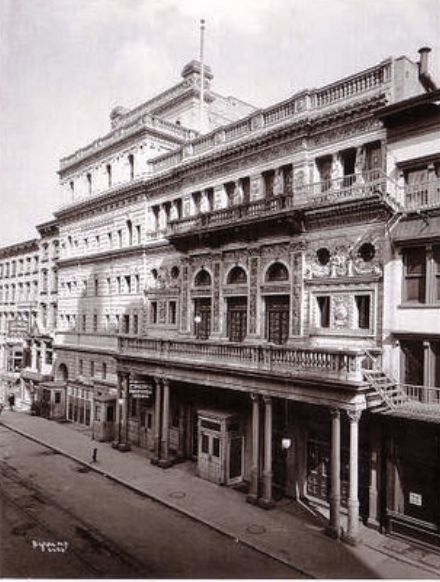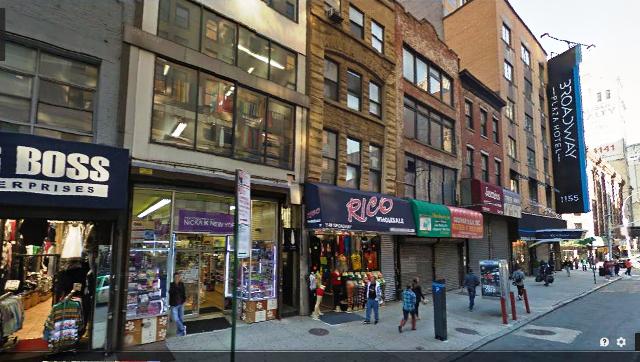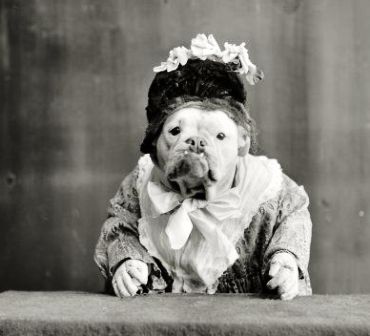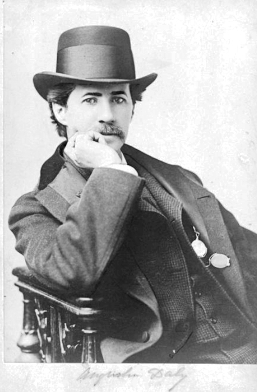During vaudeville’s heyday in the late 1800s and early 1900s, animal performances were a dime a dozen on New York stages and rooftop gardens, such as Proctor’s Fifth Avenue Theatre.
Performing dogs like Dan the Drunken Dog and Don the Talking Dog were favorites with the crowds at places like Hammerstein’s Roof Garden and Tony Pastor’s Fourteenth Street Theatre.
One of the most famous performing pooches was Uno, a nondescript male terrier that was billed as “The Mind-Reading Dog,” “The Educated Dog,” and “The Dog with a Human Brain.” Uno was the prodigy of J.C. Pope, a vaudeville performer and agent aligned with John R. Price’s Popular Players touring theater troupe.
After spending several years performing in California and the Midwest, Uno and Pope made their New York debut in 1909 at Keith & Proctor’s Fifth Avenue Theatre, which was located just off Broadway at 31 West 28th Street. According to a review of the 13-minute show in Variety, Uno was a big hit with the audience, not so much for what he did, but for how he did it (in other words, I think he was a bit of a drama queen).
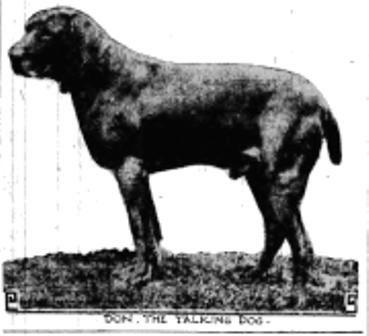
The performance began with Uno walking on stage all dressed in female attire, from cloak and dress to corset and other feminine undergarments. One by one, J.C. Pope would remove each item of clothing in a manner that mimicked burlesque – which got a lot of laughs – and then he’d ask Uno to pick them up as he called for each item.
Uno also picked up coins of various denominations as well articles from the audience, such as a watch or pipe. The act would always conclude with Uno and Pope playing a musical selection on the bells (J.C. played all but one bell and Uno was trained to chime in with his bell at the appropriate time).
According to most reviews, Uno was a male dog. But in one theater review, the critic reported that Uno was a female dog:
Uno is a success and her stay in vaudeville may only he determined by the years she remains upon Mother Earth. The fourteen minutes of her act were none too many.—The New York Dramatic Mirror, April 30, 1910
Uno also apparently had an understudy in case she (or he) was unable to perform for whatever reason. As for actual mind reading, my research did not reveal any demonstrations of this talent.
The Fifth Avenue Theatre
The Fifth Avenue Theatre on West 28th Street – and the ground on which it was built – has some very interesting history going back to the 1600s. I’ve also discovered some old photos from an architectural review of the new theater (Scientific American Building Monthly, January 1893) that I think many readers will enjoy.
The land goes back in American history to about 1670, when Sir Edmond Andros granted a land patent to Solomon Peters, the son of Pieter Santomee, a free African American who had once worked for the Dutch West India Company. In his will dated November 30, 1694, Solomon bequeathed his land, including 30 acres bounded by Abington Road (21st Street), the Bloomingdale Road (Broadway), Seventh Avenue, and 28th Street, to his wife, Maria Antonis Portugues.
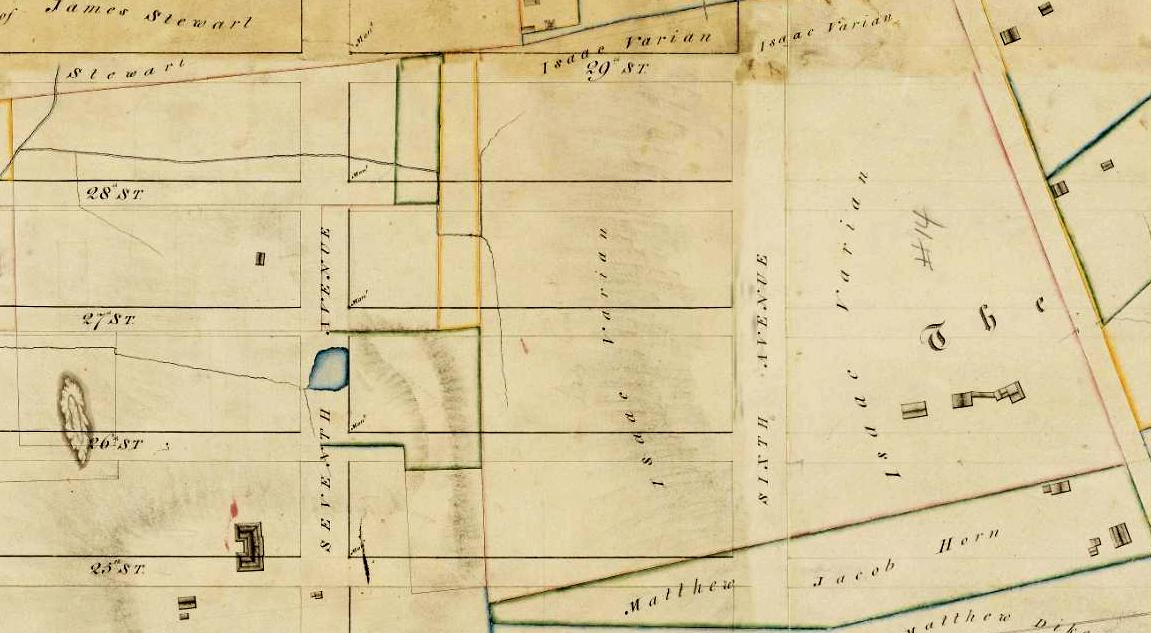
In 1716, Maria’s heirs (which may have included grandson William Smith of Orange County, NY), conveyed the land to John Horn, a wheelwright, and Cornelius Webber, Horn’s brother-in-law. In 1751, Jacob Horn conveyed about 17 northerly acres of the Horn farm to John De Witt, a Dutch farmer.
Along comes Isaac Varian, a butcher and farmer, who purchased the land from De Witt’s executors for 1,280 pounds in 1787. Isaac established his homestead on the Bloomingdale Road (Broadway) just north of 26th Street (see map above), where he lived until his death. (And Varian lived quite the life: He was married three times, had 16 children, and was 79 years old when he died in 1820.)

Over the years, starting around 1830, the many heirs to the Varian estate began selling off their allotted lots to individual buyers and speculators. But one great-granddaughter, Lucy Varian, held fast to her land.
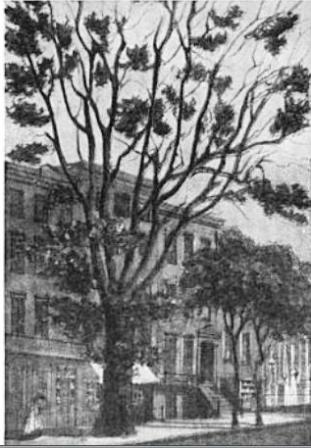
Even after Lucy married Henry Gilsey, the son of real estate mogul and city alderman Peter Gilsey, she refused to sell to her own father-in-law. He had to lease the land on which he built his house and performance hall on West 28th Street.
Gilsey’s Apollo Hall
The Fifth Avenue Hotel began as Apollo Hall, which was erected by Peter Gilsey on the north side of 28th Street, a few doors west of Broadway, in 1868. Gilsey also built a rowhouse next door at 33 West 28th, where he and his family lived.
Apollo Hall was only two stories, with the upper floor used for lectures, readings, balls, and political meetings; the lower floor for public amusements. It opened October 16, 1868, with a concert by Jerome Charles Hopkins, founder of the Orphean Free Schools for musical instruction, the proceeds of which went to the school’s fund.
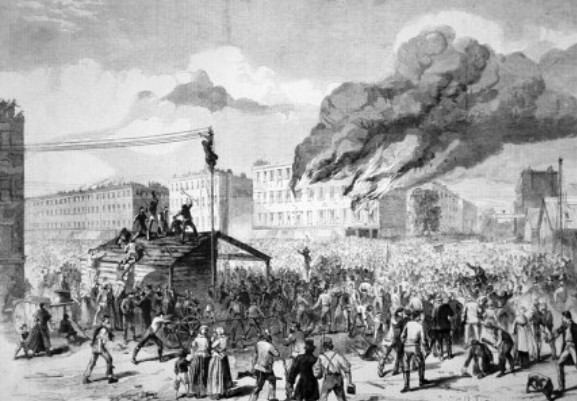
Soon thereafter, the hall underwent a complete overhauling and was reopened April 17, 1871, as Newcomb’s Hall (W. W. Newcomb, manager). Six months later, John E. McDonough and H. A. Eamshaw took over management and reopened the hall on October 23, 1871, as The St. James Hall and then the St. James Theatre.
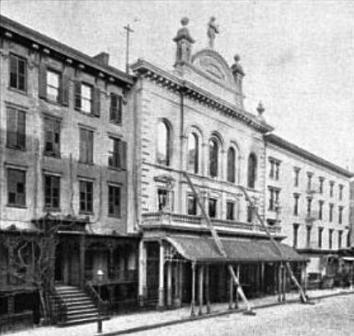
In June 1873, the Gilsey estate began transforming the building into a true theater with seating for 1,900 people. The work was completed in December 1873, whereupon theater manager and playwright John Augustin Daly obtained a lease for the new venue. Daly was in need of a new theater, having lost his Fifth Avenue Theatre on 24th Street (adjacent to the Fifth Avenue Hotel) in a fire on January 1, 1873.
Daly opened the new theater on December 3, 1873, and renamed it the New Fifth Avenue Theatre. He continued as proprietor until 1877, which was the same year a ventilation system was installed that blew air over blocks of ice, making the venue the world’s first air-conditioned theater (there’s a good trivia question for you).
Daly was followed by John T. Ford, who removed “New” from the name, and then Eugene Tompkins, “the Napoleon of theater managers,” took over the lease on the building.
Here’s where the plot thickens a bit.
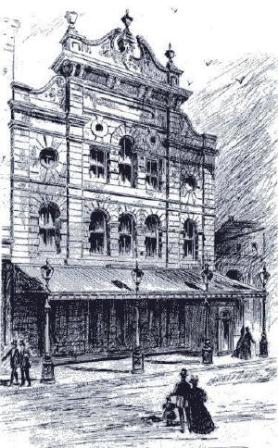
In 1889, Andrew and Henry Gilsey, two of Peter’s seven children, decided to demolish the house and the old theater and build a new theater facing Broadway.
To help finance this plan, they told Tompkins they would only renew his lease in 1891 if he agreed to make repairs to the old theater and also build a new theater at a cost from $100,000 to $150.000 in 1891.
Tompkins refused the terms of the deal. Turns out he had discovered that while the ground covered by the auditorium belonged to Peter’s sons, the ground covered by the stage still belonged to Lucy Varian Gilsey (remember her?), who, surprise, surprise, refused to renew the lease under any terms (so much for building a new theater).
Tompkins turned the lease over to H.C. Miner for the 1890-91 season. Those in the theater industry who read the terms of the lease felt that Miner was getting a bad deal, since it would probably cost more than $150,000 to build a new theater.
A Timely Conflagration
“They did all in their power, but the place was like a tinder box, and its four high walls were like a chimney. The fire whirled and swirled in it pits, and as it rolled upward and spread out in the wind it made one of the most imposing spectacles that New York has seen in years.”—New York Times, January 2, 1891
Well, wouldn’t you know that a curious thing happened on January 2, 1891, about a half hour after all the performers in that Friday evening’s production of “Cleopatra” had left the building. At about 11:45, night watchman Daniel Finn reported flames coming from the cellar of the theater. There was barely enough time to grab a few stage props and run.
By the time firemen arrived on that windy night, the fast-moving fire was not only burning down the theater but also threatening to destroy several other nearby buildings, including 1185-1193 (I.&I. Slater), 1195 Broadway (Herrmann’s Theater), 1182-1196 Broadway (Sturtevant House), and 33 West 28th Street (Mrs. Peter Gilsey’s residence).
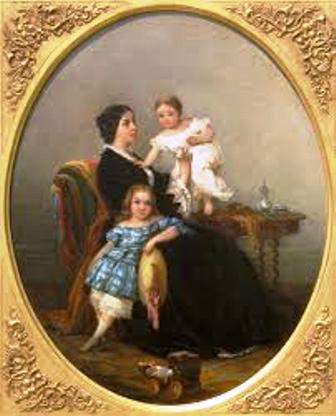
According to a report in The New York Times the next day, the Gilsey brothers, and Harry Miner, in particular, didn’t seem too upset as they watched the flames destroy their property:
“Harry Miner, the proprietor of the Fifth Avenue Theatre, was one of the coolest of the spectators. He looked on the flames that were consuming his property and was not once heard to bemoan his misfortune.”
Andrew Gilsey estimated the total loss at $156,000, including damage to the home and complete destruction of the theater. He told the press he had $80,000 in insurance coverage (a nice amount to put toward a new building). Harry Miner’s loss was about $30,000, but he had $20,000 of insurance coverage.
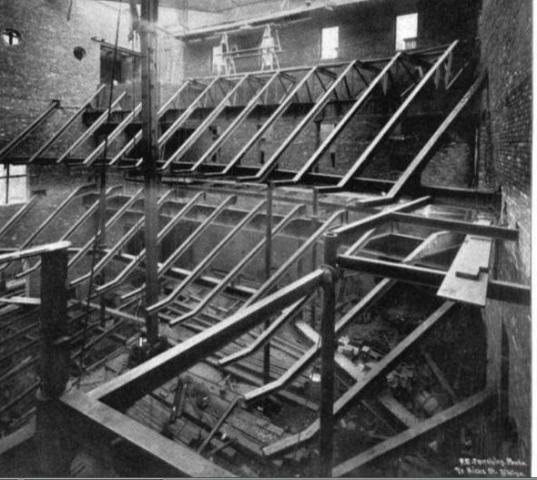
An investigation into the origin of the fire was made by the Fire Marshal, and it was his opinion that the flames were started by a lighted cigarette (and maybe an accelerant of some sorts?).
A New Fifth Avenue Theatre
With insurance money and a good excuse to build a new theater (and by this time Lucy had finally given in and began selling off her lots), the Gilsey estate promptly hired architect Francis Hatch Kimball to rebuild a new, fireproof Fifth Avenue Theatre.

The Neo-Classical structure featured heavy terra-cotta decoration, gilt plasterwork, and a richly decorated entrance on West 28th Street (the main entrance was later moved to 1187 Broadway). The auditorium was parallel with 28th Street, while the stage occupied the site of the old Gilsey home.
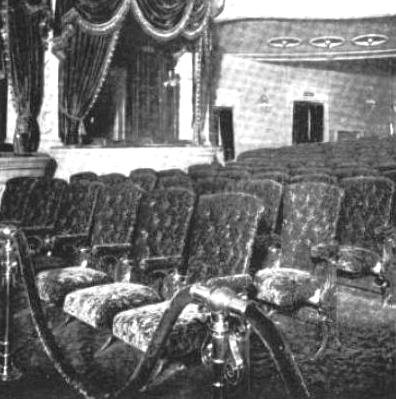
The new Fifth Avenue Theatre opened on Saturday night, May 28, 1892, with Maurice Barrymore’s and Charles Poemer’s comic opera, “The Robber of the Rhine.”
Henry Miner continued to manage the theater until Frederick Freeman Proctor took control in 1900. Proctor teamed up with Benjamin Franklin Keith, and in 1906 the vaudeville chain redecorated the theater for vaudeville presentations — like Uno the mind-reading dog.
When their partnership dissolved in 1911, the theater was renamed Proctor’s Fifth Avenue Theatre.
By 1915, Proctor was showing motion pictures in addition to vaudeville acts. Sometime after 1929, Proctor bowed out and movies were replaced by burlesque shows. On April 8, 1936, Emigrant Industrial Savings Bank acquired the property in a foreclosure.
The old theater was demolished in 1939.
